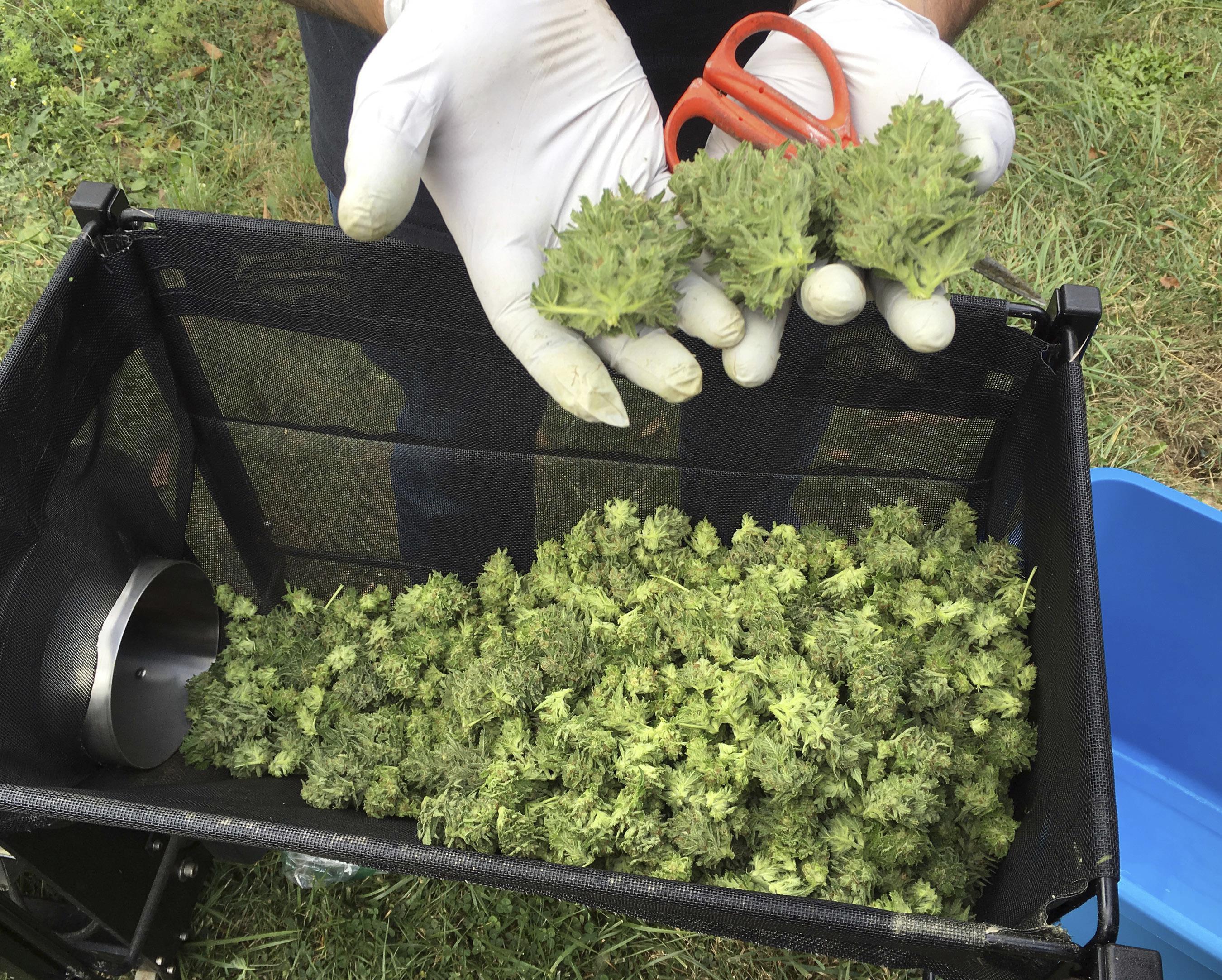
In this Sept. 30, 2016, file photo, a marijuana harvester examines buds going through a trimming machine near Corvallis, Ore.
Andrew Selsky / AP Photo
The Oregon Liquor Control Commission will soon announce new cannabis harvest regulations.
The harvest doesn't arrive until September, but a large over-supply of cannabis last year seriously depressed prices. And state regulators worry all that excess cannabis is flowing into the black market. If that market grows too big, it could prompt a federal government crackdown.
So the OLCC has drafted new rules to better monitor the harvest. The rules would require outdoor growers give the state advance notice before harvesting and several possible harvest dates.
The goal is to keep growers focused only on the amount of cannabis that can be sold on the legal, regulated market; a rogue grower, the thinking goes, will be less likely to divert crops to the black market if they know regulators could turn-up at any time.
But the idea of more monitoring is getting significant pushback from growers.
Many question how much cannabis is being diverted away from legal sellers. And they say the cannabis harvest is like the grape harvest in that timing is everything. Too early, and the plants haven’t had time to bulk up and produce the precious chemicals that make cannabis unique.
"Harvesting late, you're looking at loss for a different reason," said Pete Gendron, president of the Oregon SunGrowers Guild. "You can have these massive flowers that get damp at night and may not thoroughly dry out during the day, and you can wind up with different types of rot and mold that occur because the flower is so dense that it no longer allows any kind of circulation."
One dead bug can rot and ruin a whole flower. Gendron said timing is so important that growers monitor crops with a magnifying glass — they're waiting for the tiny crystals that form on the flowers to be just the right cloudy, amber hue.

Cannabis on display on Saturday, April 16, 2016, at the Hemp & Cannabis Fair at the Oregon State Fairgrounds in Salem, Ore. The fair celebrates legal marijuana and features hemp and cannabis products, accessories and tools, including harvest equipment.
Danielle Peterson / Statesman Journal
He said growers often can’t say on Tuesday that they’re going to harvest on Wednesday. A few cool nights or a large dump of rain can change everything.
"I think everybody knows that cannabis is legendary for sticking to just about everything," Gendron said. "And you don’t know at that point if it’s being turned into a smokable product, or an edible or a topical product. But you do know that you don’t want to introduce dirt and other contaminants into the manufacturing process.”
The director of the OLCC, Steve Marks, said giving the state a few specific times for harvest is not overly burdensome for growers.
“This one’s pretty easy," he said. "We want them to punch the buttons to say when they’re going to harvest. And we’re going to make it as simple as possible to do that. We understand weather events take place. You don’t get the work crew out that day.”
Marks said the state is just asking for the same kind of notice that agricultural food processors get from farmers who grow things like corn and green beans.
"NORPAC's big co-op processes food throughout the Willamette Valley. They know when their growers are harvesting," he said. "They're set up to take the produce in. They've got contracts. They've got delivery dates. They've got testing."
And, Marks said, the harvest isn’t the only date the state wants to know about.
“The drying period, when marijuana is being dried out, is another area where people are pointing to that diversion may be happening," he said. "Our point is, we’ll find out."
The OLCC dictates the size of the canopy each cannabis grower is allowed. The canopy is the portion of the crop that grows above ground. It's formed by the crowns of all the individual plants.
By tracking the harvest and the drying period, the state hopes to be able to put solid numbers on Oregon’s official cannabis production — and by a process of deduction, the size of the black market.
The agency is under pressure from federal officials, including Oregon U.S. Attorney Billy Williams, to control oversupply. Recreational and medical marijuana are legal in Oregon and Washington, but still illegal at the federal level.
“We have an identifiable and formidable marijuana over production and diversion problem,” Williams said earlier this year after the Trump Administration gave U.S. attorneys more leeway to prosecute marijuana businesses.
None of this changes the mind of Pete Gendron with the Oregon SunGrowers Guild. He says trimming and drying rooms are finely tuned operations, designed to process the cannabis as efficiently as possible.
“Apologies to the OLCC here, but it would be like having a 5-year-old in the middle of the room, underfoot, peppering you with questions all day long," he said. "Not only not contributing to the process, but actually slowing it down, and costing the business money."
Gendron said that if the state is worried about cannabis processors stuffing their pockets full of flower, they need only check the 90 days of recorded security footage businesses are required to keep.
“You’re more than welcome to take a seat in the camera room and eat popcorn and watch what we’re doing on a dozen different cameras," he said. "But I can’t have you underfoot in the processing area, unless you’re sanitary and properly dressed. It’s just not going to work."
The state says their inspectors would wear the right gear and observe rather than interrupt the harvest.
The new rules could be voted on at the state liquor commission's July 26 meeting.
Last year, Oregon’s marijuana business did about $500 million dollars worth of retail trade. That’s 80 percent the size of alcohol sales. But alcohol sales are relatively stable, while marijuana sales are increasing 20 percent a year or more.
The OLCC is currently conducting a study on cannabis supply and demand. It should be ready for presentation to the legislature next year.
Some other states, including Washington, already limit supply. Marks said the Oregon legislature could also decide to impose limits.
“That’s not our job to do at OLCC. We’re going to provide them information about how to make those decisions," he said.
Earlier this year, the OLCC stopped processing any new recreational cannabis business license applications. Marks said that’s not because they don’t want new businesses, but because they were swamped with re-licensing existing businesses.
Oregon’s cannabis market started slowly, with early adopters facing a lot of problems as the state developed new rules and the necessary infrastructure was built.
But once the industry became more established, the market took off.
Oregon now has about 1,900 licensed marijuana businesses. Production is so large that marijuana is becoming a commodity. That means businesses are creating so called "value-added products," such as edibles and tinctures, for which they can charge more than raw flowers for smoking.
Businesses are also trying to formulate their own brands, to differentiate themselves from the competition and to reassure customers that what they’re buying will be the same every time.
Marks said the early gold-rush days have come to an end, but well-funded investors are becoming increasingly interested in cannabis.
“You have more of these players that see a great opportunity in the future nationalized, billions of dollars, U.S. marijuana economy," he said. "And they’re raising great amounts of capital to try and acquire and consolidate these businesses."
